Burma Army must be held accountable for extrajudicial killing of seven villagers in Mong Yaw
By Shan Human Rights Foundation • July 13, 2016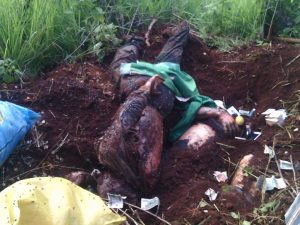
Interviews carried out by SHRF with local witnesses show clearly that the Burma Army were responsible for the deaths of seven villagers in Mong Yaw, Lashio district, in June 2016. SHRF therefore urges the NLD-led government to take immediate action to ensure that the military personnel responsible for this crime are brought to justice.
Timeline of the killings
The incident took place about half a mile west of the town of Mong Yaw, Lashio district, northern Shan State.
On June 25, 2016 about 100 Burmese troops from Light Infantry Battalion (LIB) 362 arrived at the village of Mong Yang (about 10 kms west of Mong Yaw) from the Namjalarp-Loi Tao area (in the north). From Mong Yang, the troops walked in a line along the road east towards Mong Yaw. At about 2.30 pm, when the soldiers in front were about half a mile from Mong Yaw, they began stopping all the traffic along the road. Cars and motorbikes coming from Mong Yaw were stopped and the drivers asked if they had seen Shan soldiers, and if they had any guns. Also cars and motorbikes coming from the direction of Lashio, were blocked at the Pankay Loung Moon intersection, and interrogated in the same way. No traffic was allowed to pass either way, and no vehicles were allowed to return to Mong Yaw once they had been stopped. At that time, the troops were spread along a two-mile stretch of the road.
By 3 pm, about 10 cars and 30 motorbikes were stopped on the road near Mong Yaw. At that time, the drivers waiting by the road saw a motorcycle coming along a side road towards Mong Yaw. There were two villagers riding the motorcycle. As they got closer to the main road, the Burmese soldiers called out to them to stop, but they kept going. The Burmese troops first shot into the air, and when they didn’t stop, they shot directly at them, killing them both. This was seen clearly by the drivers of vehicles stopped on the main road.
Hearing these shots, the other Burmese troops further along the road also began shooting their guns and firing mortar shells. Drivers of the blocked vehicles then saw some Burmese soldiers sending a camera drone up into the sky, apparently to search for any enemy troops in the area. The Burmese troops were seen using walkie-talkies and reporting that the drone had spotted villagers farming in fields on either side of the road. To the south of the road were sisal plantations, and to the north were corn farms.
The soldiers were then seen going into the surrounding fields and arresting villagers who were farming. There were around one hundred villagers farming around the area, but most were able to run away from the soldiers.
A woman who was farming in a corn field north of the road, described being arrested with ten other villagers (five women and five men): “While we were farming in the corn field, we heard bombing and shooting. We decided to hide at the hut in the farm. Then a group of Burmese soldiers saw us, and walked towards us and asked us to come out of the hut. They asked us if we had seen any Shan soldiers, and if we had heard the sounds of guns. We answered yes, we had heard the sound of firing coming from that hill. One of their commanders then said OK, that’s enough. Then they shot their guns around the hill four and five times. Some of them looked around there, but there was nothing, and then they took us down to beside the road where some other soldiers were waiting. It was about one mile away from where we were working. About 5 minutes after we got there, they asked us questions again and again. Later, they took Ai Maung and Ai Shwe Hlu a little bit far away from us, and asked them questions in Burmese. Ai Maung said he didn’t understand Burmese, as he was Ta’ang. They pulled them close to the fence by the road, and slapped them, then beat them with rifle butts. Then they tied up their hands.”
Drivers parked on the road witnessed these villagers being beaten. They also saw Burmese soldiers bringing a group of about seven women, who were crying, down to the road, one of whom had been hurt. They had been working together in a corn field near Loi Bu when a mortar shell exploded near them, slightly injuring one of them. The soldiers treated the wounds of the one who had been injured, then let the women go.
Meanwhile, another three male villagers (Sai Ai Hsai, Sai Ai Maung and Sai Ai Lord from Wan Kurt) arrived at the checkpoint on motorcycles. One was on his way home from farming, one was coming to pick up his grandmother who was farming, and one was coming to pick up his daughter who was farming. They were also stopped and interrogated together with the farmers. Drivers waiting by the side of the road also saw them being beaten by the soldiers.
By this time, it was already getting dark. At about 7.30 pm the road block was lifted and the vehicles were allowed to continue on their way.
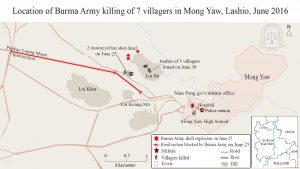
All of the villagers who had been detained by the road were allowed to return home, except for five men: the three motorcyclists from Wan Kurt and the two farmers who had been interrogated separately. They were seen being taken by Burmese soldiers up the hill towards Loi Bu.
One of the women farmers said: “We saw the Burmese soldiers take Ai Maung, our cousin Ai Shwe Hlu, and the three men from Wan Kurt, back up the hill to the farm where we had been working. Soon afterwards, they let us go back home It was really dark when we arrived home, around 9 pm.”
The five men were not seen alive again.
Finding the missing villagers, and attempts to seek justice
In the evening of June 25, relatives of the five detained villagers requested help from the Mong Yaw township authorities to ask the Burmese troops for their release. However, the authorities were reluctant to help. They also discouraged them from filing charges with the police, as the case involved the military. They said it would cost a lot of money to take the case to court.
The wife of one of the missing villagers said: “On the day they were arrested, at night we also tried to get help from the local Mong Yaw authorities. We went to their office and begged them for help. But they said as it was getting dark, they dared not go out as the soldiers might come.”
Only the Mong Yaw headman was willing to help that night, and tried to meet with the commanding officer of the Burmese troops, who had set up camp in the Mong Yaw high school. However, he was told by a soldier on guard that if anyone came near their camp to ask about this matter, they would be shot.
The next day, on June 26, the Burmese troops announced that no villagers were allowed to go out of the town to farm their fields for the next three days. The same day, the Mong Yaw police chief and the town administrative secretary tried to ask the Burmese troop commander to release the five villagers, but they were told that the villagers had already been released on June 25.
This was described by the wife of one of the missing villagers: “In the morning (of June 26) when we tried again, they (the Mong Yaw authorities) just said wait, wait, and when an official phoned to high-level Burmese officers, they said they had already released them.”
During this time, the Mong Yaw high school was shut for four days, and the hospital was also shut for three days. Villagers were extremely afraid of the troops stationed in the town, and few dared even go out to the market.
Only on June 29, when the villagers were allowed out to their fields again, were they able to find the bodies of the missing men. First they found the bodies of the two men riding a motorcycle who had been shot and killed on the road. The bodies had been dragged to a ditch by the side of the road and covered with a net and some leaves. No one was able to identify these two bodies at first, so they just buried them in the earth where they were found.
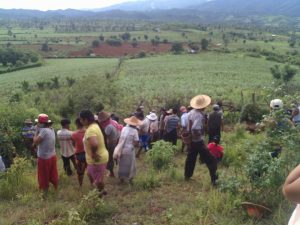
After that, they found two patches of freshly dug earth near a corn farm at Loi Bu, and uncovered the bodies of the five missing villagers.
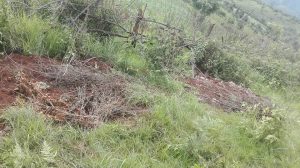
Ai Shwe Lu’s aunt said: “At around 11 am, we found two new holes which had been dug and which smelled bad, above the corn field where we were working. So some villagers dug up the holes, and we found the dead bodies there. My nephew and Ai Maung were in one hole, and in another hole were the three men from Wan Kurt. When we found Ai Shwe Lu and Ai Maung’s bodies, they both were wearing soldier’s trousers, but without any belt. Their mouths were gagged with red towels. Ai Shwe Lu had two bullets in his chest, and two bullets in his stomach. Ai Maung’s head had been beaten in.”
The military camouflage trousers had been pulled over the top of the civilian trousers of the two men According to Ai Maung’s wife: “The military trousers were too big for him. They clearly didn’t belong to him.” Military trousers had also been put on one of the bodies of the Wan Kurt villagers.
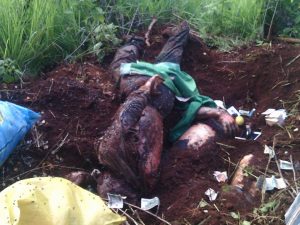
On July 2, a funeral ceremony was held for the five villagers at Vihara temple in Mong Yaw. Monks were invited from four temples, including from a temple in Lashio. The ceremony included Buddhist and Christian sermons, and both Shan and Ta’ang customary practices.
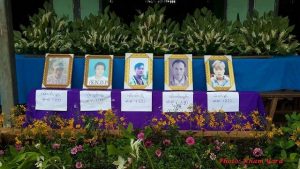
On July 2, the troops of LIB 362 left Mong Yaw.
It was not until July 4 that the other two bodies (of the villagers who had been shot while driving a motorcycle) were identified. These two men, Naw Tint and Sai Hla, were brothers, who lived near Lashio. They had come to Mong Yaw to collect Naw Tint’s wife, as they needed her help in their farm for the coming growing season.
At first the brothers were not missed, but by early July, when they had not returned home, their family members began to worry they may have been involved in the incident at Mong Yaw. Therefore, on July 4, five family members, including their elder brother, younger brother and an uncle came to Mong Yaw to look for them.
They went to the site where the two motorcyclists had been shot, and recognized some of the possessions of the two brothers scattered on the ground.
Their uncle said: “We found their hats, sunglasses, wallet, sandals, so we were sure that they were the ones who had been killed. We also asked around with other relatives, to see if they had gone to any of their houses. When we got back to our village, we informed this to the village head. We also went to report the case to the No 1 police station in Ee Nai (our village tract). The police said they would accept the case at first as a ‘missing persons’ case.” The police also advised him to report the case at the no. 2 police station in Lashio.
On July 6, the uncle and other relatives went again to Mong Yaw, together with an MP of the Shan Nationalities League for Democracy (SNLD) political party and a journalist. This time, they dug up the soil to look at the bodies. Even though the bodies were badly decomposed, the uncle recognized the clothes that his nephews had been wearing.
That day, they also went to file the case again at No. 2 police station in Lashio. They went with their local MP, their village head, and several respected elders from their village, to the police station. They met with the deputy police chief of the station, who accepted the case, but gave no clear reply about how it would be dealt with. He said he would be in touch with them for a further appointment.
Details of the villagers killed
| No | Names | Age | Ethnicity | Village of residence | Family | Details of killing |
| 1 | Naw Tint | 33 | Loi Hla (a Wa sub-group) | Nam Yao village, Ee Nai village tract, near Lashio town | Married with 2 children | Shot dead while riding a motorbike – going to pick up his wife |
| 2 | Sai Hla (brother of Naw Tint) | 30 | Loi Hla (a Wa sub-group) | Nam Yao village EeNai village tract, near Lashio town | Married with 2 sons and 1 daughter | Shot dead while riding motorbike – going with his brother to pick up his sister-in-law |
| 3. | Sai Ai Hsai | 23 | Ta’ang | Wan Kurt village, Mong Yaw | Married with 2 sons | Arrested while riding a motorcycle home from working on a corn farm, beaten, body found buried |
| 4 | Sai Ai Maung | 27 | Ta’ang | Wan Kurt village, Mong Yaw | Single (lived with 60-year-old grandmother) | Arrested while riding a motorcycle to pick up his grandmother at a corn farm, beaten, body found buried |
| 5 | Sai Ai Lort | 35 | Ta’ang | Wan Kurt village, Mong Yaw | Married with 1 daughter and 1 son | Arrested while riding a motorcycle to pick up his daughter working on a farm, beaten, body found buried |
| 6 | Sai Shwe Lu | 17 | Shan | Wan Tap village, Mong Yaw | Single | Arrested while farming, beaten, body found buried |
| 7 | Ai Maung | 25 | Ta’ang | Wan Tap village, Mong Yaw | Married with 2 daughters and 1 son | Arrested while farming, beaten, body found buried |
Public responses by the Burma Army
Initially, there was a high-level attempt by the Burma Army to deny responsibility for the killings, and to place the blame on ethnic armed resistance groups.
On July 2, 2016, the Burmese military-owned Myawaddy newspaper reported that bodies of seven people had been found after the Burma Army had been attacked by “SSA” and “TNLA” troops near Mong Yaw. The report claimed that two of the corpses were “enemy” corpses, which were found with money (1.9 million kyat) and drugs (2,000 methamphetamine pills) on them. They said the other five corpses were found together with ammunition in the “conflict area” and that they were searching for the murderers of these men. This news was also reported on July 3, in the government newspaper, The New Light of Myanmar (“Army men seek suspects after discovering seven corpses in Mong Yaw”).
However, many other media reports had directly implicated the Burma Army in the killings. Probably in response to this, on July 3, 2016, at about 11:30 am, Major-General Kyaw Kyaw Soe, the Burma Army Northeastern Deputy Regional Commander from Lashio, came with Major Kyi Win, and Captain Win Kyaw to meet the families of the five victims in Mong Yaw, at the town administrative office. During this meeting, photos were not allowed to be taken. There was a translator, and the secretary of Mong Yaw and Mong Yaw police chief came and listened. On the villagers’ side, 2 of the mothers and 4 of the widows of the dead villagers came. The military officers asked about the events on June 25, 2016. They interviewed the relatives one by one. Finally they said they believed that the villagers killed were indeed civilians. The relatives were relieved to hear this, as they had maintained the innocence of the victims all along.
Then the deputy regional commander, Major-General Kyaw Kyaw Soe gave each of the victims’ families 300,000 Kyats (255 USD), but said that this was not to be seen as “compensation” and was not related to the investigation. He said he had just come to find out the facts and take notes, and what the villagers said would be checked again for accuracy. He said that the process was not finished yet, and the money he had given was simply a personal donation out of pity for the young children of the victims. Altogether he gave 1,500,000 kyat (1,280 US$). He told the villagers, “This kind of incident will not happen again.”
Despite the commander’s words, local villagers remain in fear of Burmese troops, who are continuing to patrol in the area. The relatives of the villagers killed also have no idea whether the military are taking any action against the troops who carried out the killings. They told SHRF that they would like to seek justice.
Urgent need to end cycle of military impunity
Interviews by SHRF provide evidence that troops of Burma Army LIB 362 committed the following crimes:
- They shot and killed two villagers on motorcycles simply for not stopping as ordered.
- They fired mortar shells indiscriminately into an area where villagers were farming, causing civilian injury
- They arrested, tortured and killed 5 innocent villagers, and then put military camouflage trousers on three of the bodies to make it look like they were soldiers.
SHRF deplores these crimes, the high-level attempts to cover them up, and the reluctance of local authorities to assist with the cases.
SHRF calls urgently on the NLD-led government to take action to bring the perpetrators of these crimes to justice and end the military impunity which is threatening the lives of innocent civilians throughout the country.
Contact
Nang Charm Tong +66: (0) 81-630-6655 (English, Shan, Thai)
Sai Hor Hseng +66: (0) 62- 941-9600 (English, Shan)
Sai Kheun Mai +66: (0) 94-638-6759 (English, Burmese)
Download this updated in English here.
ေနာက္ဆုံးရသတင္းအခ်က္အလက္မ်ား ျမန္မာဘာသာကုိ ဤေနရာတြင္ရယူႏုိင္သည္။
ေနာက္ဆုံးရသတင္းအခ်က္အလက္မ်ား ရွမ္းဘာသာကုိ ဤေနရာတြင္ရယူႏုိင္သည္။
Tags: Human Rights Violations, Military Engagement, National League for Democracy, Shan Human Rights Foundation, Shan StateThis post is in: Crimes Against Humanity, Ethnic Nationalities, Human Rights, Law, Military Regime
Related PostsOpen letter to President regarding Myanmar National Human Rights Commission Reform
Latest Human Rights Abuse Case Demonstrates Urgent Need to Reform the Myanmar National Human Rights Commission
Assistance Association for Political Prisoners-Burma’s Statement
Armed Forces and Democratization in Myanmar: Why the U.S. Military Should Engage the Tatmadaw
Latest Burma Army attack on strategic SSPP/SSA mountain base stokes fears of major war escalation









 All posts
All posts